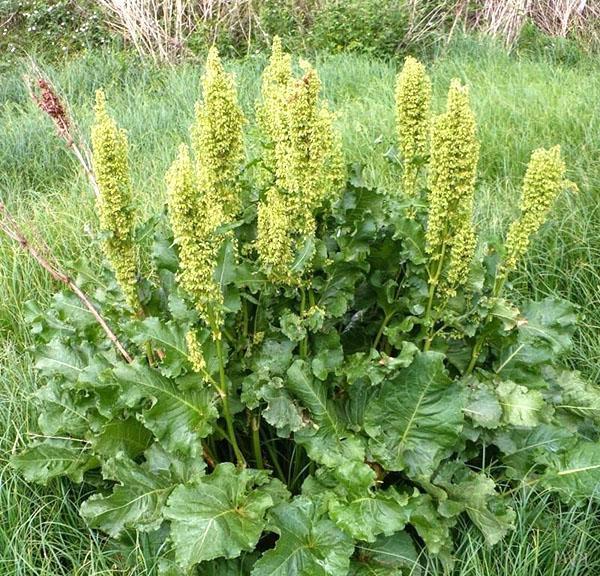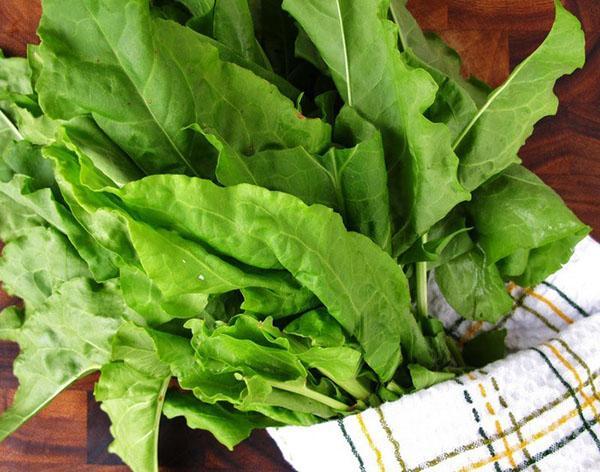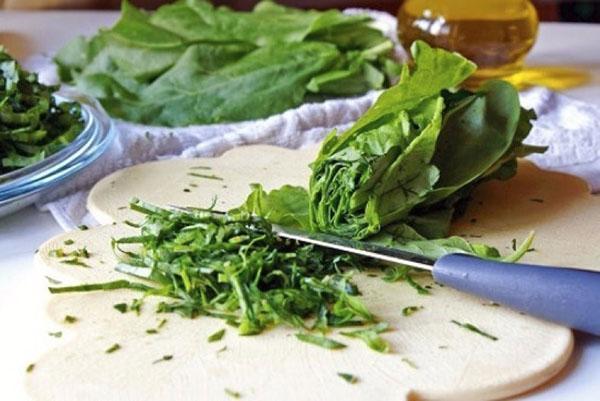Horse sorrel - composition and useful properties, recommendations for use, restrictions and contraindications
 In meadows and pastures, near roadsides, along the banks of water bodies, you can find a single plant with several powerful stems, thick and large leaves. Horse sorrel attracts attention due to its external resemblance to garden sorrel. Its green leaves do not have the usual sour taste, they are slightly bitter. The medicinal properties of horse sorrel are preserved throughout the summer, and in late autumn, you can use the seeds and root part. Culture has found extensive application in all spheres of human life - everyday life, medicine, cosmetology, cooking, veterinary medicine, leatherworking, and needlework.
In meadows and pastures, near roadsides, along the banks of water bodies, you can find a single plant with several powerful stems, thick and large leaves. Horse sorrel attracts attention due to its external resemblance to garden sorrel. Its green leaves do not have the usual sour taste, they are slightly bitter. The medicinal properties of horse sorrel are preserved throughout the summer, and in late autumn, you can use the seeds and root part. Culture has found extensive application in all spheres of human life - everyday life, medicine, cosmetology, cooking, veterinary medicine, leatherworking, and needlework.
Description and places of growth

The powerful plant can reach a height of 1.5-2 meters, has large oval-triangular leaves, which are concentrated at the base. The perennial grows singly, preferring hillsides, ravines, river banks, open areas overgrown with weeds. Dense thickets of sorrel can be seen in places with sandy soil and high humidity. The culture does not grow in swamps and lowlands.
An important feature that distinguishes the equine species from others is the leaves, which are pubescent on the underside. The rhizome is short and thick, not strongly branched. Flowers form in late May or early June, they gather in a long and dense inflorescence, similar to a panicle.
Composition and medicinal properties
 Horse sorrel contains many biologically active substances that are beneficial to health. Their greatest concentration is achieved in the root of the medicinal plant.
Horse sorrel contains many biologically active substances that are beneficial to health. Their greatest concentration is achieved in the root of the medicinal plant.
All sorrel varieties contain oxalic acid. In the human body, it promotes the absorption of calcium, which is necessary for the strength of bones and teeth.
What does horse sorrel help from - the composition and medicinal properties of the plant:
- anthraquinones - substances with a complex composition, have a pronounced laxative effect;
- glycosides are an extensive organic group of compounds that irritate nerve endings and receptors;
- tannins or tannins - a class of nitrogen-free compounds capable of producing an astringent and enveloping effect;
- coumarins - derivatives of ortho-hydroxycinnamic acid, have an antispasmodic and vaso-strengthening effect;
- flavonoids - substances of the phenolic group with bactericidal and anti-inflammatory properties;
- leukoanthocyanidins or plant polyphenols - react and create a stable protective film on the surface of the mucous membranes.
The green mass of horse sorrel contains pectin, carotenoids, sucrose, vitamins K and C, organic acids, most of all citric and lactic.They normalize the acid-base balance in the body, improve digestion and bowel function, activate the secretory function, and have antiseptic properties.
Why is horse sorrel root useful?
- has a laxative effect, facilitates the act of defecation with constipation, cracks in the anus, colitis, enterocolitis, intestinal atony;
- decoctions and infusions are used as an anthelmintic in children and adults;
- promotes the formation and excretion of bile, is used internally for liver failure, cholecystitis, cholangitis;
- as a general tonic and to increase appetite in weakened and often ill children, to improve the body's defenses in adults;
- relieves pain in case of inflammation of the teeth and gums, cleans well and whitens tooth enamel, eliminates bleeding;
- for the prevention and treatment of gastrointestinal diseases, used for nausea, severity, heartburn, poisoning, gastritis, peptic ulcer disease;
- with angina, gargle, it relieves pain and inflammation, eliminates bacterial plaque;
- It is used as a hemostatic drug for internal bleeding, pulmonary, uterine, intestinal, gastric, hemorrhoidal.
Horse sorrel is widely used for hemorrhoids... The plant helps to thin the stool, which in this situation makes it easier to visit the toilet, reduces pain, and reduces inflammation.
How to use horse sorrel
In folk medicine, the use of horse sorrel is based on the correct calculation of the proportions of a medicinal plant, compliance with the terms of treatment.
Fight diarrhea
How to prepare horse sorrel root for diarrhea:
- boil 1 liter of water;
- after boiling, add 1 spoonful of dry crushed root;
- boil the liquid over low heat for 10 minutes;
- remove from heat, allow to cool;
- strain slightly warm broth;
- take 3 tablespoons 1.5 hours before meals in the morning, at lunchtime and in the evening.
According to an old recipe, sorrel was boiled together with the root in vinegar or wine. In this form, they were treated with scurvy, anthrax, plague. The sap of a fresh plant was used to treat open areas of the body; in the forest, this served as protection from poisonous insects, snakes.
Eliminate constipation
 How to prepare an infusion of horse sorrel for constipation:
How to prepare an infusion of horse sorrel for constipation:
- pour 5 tablespoons of dried and crushed root into a thermos;
- pour the dry mixture with a liter of boiling water;
- the liquid should be infused for 3 hours;
- it is recommended to strain the finished infusion;
- the agent is used internally, one table boat every 2-3 hours.
If you dry the rhizome of the plant and crush it in a mortar, you get a healing powder that treats diarrhea, removes parasites, stops bleeding, reduces pressure, relieves cough, relieves inflammation and pain. The medicine is used at 0.25 grams three times a day.
Fight against skin diseases
 Sorrel powder mixed with sour cream or butter is used to treat diathesis or dermatitis in children, scabies, purulent and non-healing wounds, abscesses, and tumors. With weak, bleeding-prone gums, the powder is added to the toothpaste, the mouth is caressed with a decoction of horse sorrel. A medicine based on oxalic powder in combination with animal fat is used against erysipelas, psoriasis, eczema, vitiligo, sarcoidosis and others.
Sorrel powder mixed with sour cream or butter is used to treat diathesis or dermatitis in children, scabies, purulent and non-healing wounds, abscesses, and tumors. With weak, bleeding-prone gums, the powder is added to the toothpaste, the mouth is caressed with a decoction of horse sorrel. A medicine based on oxalic powder in combination with animal fat is used against erysipelas, psoriasis, eczema, vitiligo, sarcoidosis and others.
It is recommended to carry out treatment with horse sorrel for a limited amount of time, maximum - 1 or 2 days. With prolonged therapy, addiction occurs, the effectiveness of treatment is significantly reduced.
How to brew horse sorrel seeds:
- one tablespoon of seeds is taken for one glass of water;
- the liquid is brought to a boil and boiled for 10 minutes over low heat;
- then you should let the broth cool;
- for ease of use, the liquid is passed through cheesecloth.
The ready-made broth is used orally for pain, cramps, heartburn, 1/3 cup 3 times a day. Outwardly, on its basis, compresses are made on hematomas, postoperative sutures, sore joints.The liquid can be used for lotions for deep wounds, bedsores, burns or frostbite, trophic ulcers. She is gargled with sore throat, used to disinfect the oral cavity after tooth extraction.
Horse sorrel in nutrition
 Can you eat horse sorrel? Fresh leaves of the plant have a bitter taste, so it is almost impossible to eat a lot of them. A few large sorrel leaves are useful to add to any green salad. It is especially tasty when combined with cucumbers, tomatoes, radishes, green onions, young garlic.
Can you eat horse sorrel? Fresh leaves of the plant have a bitter taste, so it is almost impossible to eat a lot of them. A few large sorrel leaves are useful to add to any green salad. It is especially tasty when combined with cucumbers, tomatoes, radishes, green onions, young garlic.
For prophylactic purposes, you can chew fresh sorrel foliage, but not more than one or two leaves per day.
 In Armenia horse sorrel grows high in the mountains. Sorrel leaves together with cuttings are braided and dried in the fresh air. After drying, they ferment and darken like tea, acquiring a pleasant spicy taste, all the bitterness evaporates. According to the Armenian tradition, this dish is called Aveluk and is offered in markets, shops, restaurants or cafes. They eat aveluk with flat cakes or pita bread, matsun sauce, feta cheese, cheeses.
In Armenia horse sorrel grows high in the mountains. Sorrel leaves together with cuttings are braided and dried in the fresh air. After drying, they ferment and darken like tea, acquiring a pleasant spicy taste, all the bitterness evaporates. According to the Armenian tradition, this dish is called Aveluk and is offered in markets, shops, restaurants or cafes. They eat aveluk with flat cakes or pita bread, matsun sauce, feta cheese, cheeses.
Collection, procurement and storage rules
 In traditional medicine recipes, horse sorrel is used completely, practically without a trace. In summer, for the preparation of decoctions and infusions, they take the green parts of the plant - leaves, flowers, stems. They can be eaten fresh or dried. In autumn, at the end of August - beginning of September, seeds are collected, and when the unearthly part dies off, they dig out the most valuable thing from the plant - its root.
In traditional medicine recipes, horse sorrel is used completely, practically without a trace. In summer, for the preparation of decoctions and infusions, they take the green parts of the plant - leaves, flowers, stems. They can be eaten fresh or dried. In autumn, at the end of August - beginning of September, seeds are collected, and when the unearthly part dies off, they dig out the most valuable thing from the plant - its root.
Before drying, the raw material is well washed and cut into small pieces. Fragments damaged by mold or decay are removed. You can dry sorrel outdoors, in the sun. You can dry the medicinal plant in an electric dryer or oven at a temperature of 60 °. Store the workpieces in glass containers under a closed lid.
Possible harm and contraindications
In large dosages, in violation of the rules and terms of treatment, the medicinal properties of horse sorrel are lost. Contraindications and restrictions apply to women during pregnancy and lactation, people with impaired liver and kidney function, with osteoporosis. In case of serious diseases, the medicinal plant should be used as an auxiliary therapeutic measure, after consulting a doctor. Doses and timing of use should also be discussed with a specialist in advance.
In large quantities, horse sorrel is considered poisonous, it can be poisoned.
In small amounts, oxalic acid is beneficial for health. With long-term treatment and exceeding the permissible dosages, oxalic acid accumulates in the human body. Interacting with calcium, it forms compounds of an insoluble type, which are deposited in the ducts of the liver, kidneys, and gallbladder.
There are many unique plants in nature that help people cope with various diseases. The healing properties of horse sorrel make it possible to use it internally for diseases of the stomach and intestines, relieve headaches, strengthen immunity, from stones and sand. The medicinal plant is used externally - to stop bleeding, with gynecological and skin lesions, cuts, bruises, bruises. The plant helps with colds and allergies, relieves cough, relieves a runny nose, is used to disinfect the mouth and throat. It is important not to exceed the dosage or use the product for too long